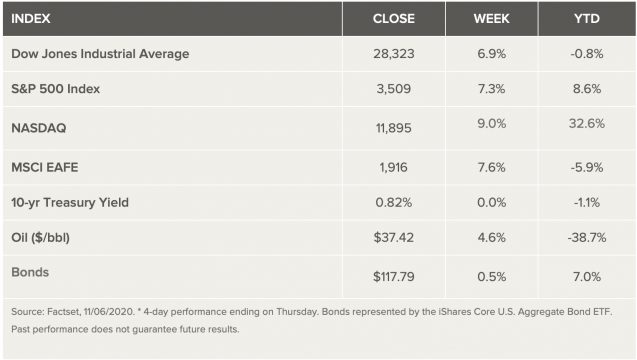

Stock Markets
U.S. stocks logged their best weekly gain since early April as investors reacted to the increased possibility of a divided government, including a potential Biden win and continued Republican control in the Senate. The final results of the U.S. election are still unknown as of Saturday. However, the market began to price in the scenario of a split government that potentially reduces the likelihood of immediate tax hikes and increased regulations, while not removing the potential for an agreement on some form of fiscal-aid package.
On the economic front, the jobs report showed that despite the lack of additional stimulus, election uncertainty, and rising virus cases, the labor market continued to heal, signaling that the economic recovery is still on track.
US Economy
Stocks rallied sharply, logging a 7.3% gain for the full week. Markets found some relief in the prospects of a divided government, with a Biden presidency and a Republican-controlled Senate reducing the likelihood of immediate tax hikes and increased regulations, while not removing the potential for an agreement on some form of fiscal-aid package. Analysts note that Washington’s composition is not yet set in stone given contested outcomes in certain states and Georgia’s two potential run-off elections for Senate seats. Analysts don’t think investors should let their guard down just yet when it comes to election-driven volatility, but we believe the week’s gains are consistent with our long-standing view that the economic recovery, along with monetary- and fiscal-policy tailwinds, will be behind the wheel as we advance, not simply the occupant of the Oval Office.
Metals and Mining
Gold edged toward US$1,960 per ounce on Friday as the US election tally dragged into its fourth day. In search of safe havens, investors kept the yellow metal well above US$1,900. A poor showing from the US dollar, which recorded its worst week since March, also aided gold’s ascent. The presidential uncertainty benefited the broader resource sector, with precious and base metals on track to end the week higher than they were on Monday. By Friday, gold had added an impressive 3.6 percent to its value since opening on Monday at US$1,889. The potential for a contested election added volatility to markets, with the Dow Jones Industrial Average slipping 158 points on Friday. It’s expected that monetary policy from the winning party will be a catalyst for gold’s further climb. Whether the yellow metal will enter record-setting territory again this year remains unknown, but Frank Holmes, CEO and chief investment officer at US Global Investors thinks US$2,000 is in sight in the short term. Longer term, he believes a price of US$4,000 is possible. On Friday, gold was valued at US$1,942.30. Silver also trended higher starting on Wednesday, but experienced some headwinds on Friday morning. Hitting US$25.93 per ounce before pulling back, the white metal added as much as 8 percent this week, its best performance since early August. Year-to-date, silver has increased 43 percent from its January start, and is positioned to continue to move higher off rising industrial and safe haven demand that favor the metal. Silver was holding in the US$25.34 range as Friday. Market volatility was also positive for platinum, pushing the catalyst metal above US$900 per ounce for the first time since September 18. Friday morning saw platinum reach US$908 before a reversal sent the metal back to the US$890 range. As platinum struggled to hold onto gains made since Monday’s US$849 start, palladium rocketed higher, adding the most to its value in the precious metals sector. Registering its best performance since March, palladium soared from US$2,077 per ounce on Monday to US$2,336, a 12 percent rise.
The base metals also trended higher throughout the week. Copper made a modest 1 percent climb in the first week of November. The red metal continues to trade near its year-to-date high of US$6,953 per tonne, which it reached on October 21. Copper’s gains this period have been attributed to a weakening US dollar index. As of Friday, copper was moving for US$6,798. Zinc prices soared to a year-to-date high this session, reaching US$2,593 per tonne. Since markets tumbled in March, zinc has added more than 46 percent to its value. On Friday morning, zinc was holding at US$2,593. After reaching its year-to-date high in late October, nickel has shed some of those gains, but remains in the US$15,000 per tonne range. A resurgence in industrial demand as supply chains strengthen has benefited the metal. Nickel was trading for US$15,450 to end the week. Despite rallying past US$1,800 per tonne this week, lead prices remain under pressure. The metal crept towards the US$2,000 per tonne range in mid-September.
Energy and Oil
It appears that Joe Biden will become the 46th resident of the United States barring the current legal challenges in play. Still, assuming Biden wins, he will take office with a divided government. He will have little wiggle room in Congress without Republican support, and he will also have his hands full with multiple crises – the pandemic, unemployment, climate change, and deep political division. Barring a sweep of two January Senate races in Georgia, presumed President-elect Joe Biden will struggle to push through major green stimulus as he had proposed unless he can somehow bring Sen. Mitch McConnell on board with concessions elsewhere. That leaves executive authority, something President Trump used heavily during his four years. A few possibilities jump out: rejoining the Paris Climate agreement, nixing Keystone XL and possibly the Dakota Access pipeline, slowing down drilling in Alaska and reinstating methane regulations on drilling. Plenty of other actions are possible, but may not be immediate, such as stricter fuel economy standards, reduced permitting for drillers on federal lands, greater environmental enforcement, etc. But big-spending items will require an act of Congress. Natural gas spot prices fell at most locations this week. The Henry Hub spot price fell from $3.06 per million British thermal units (MMBtu) last week to $2.60/MMBtu this week. At the New York Mercantile Exchange (Nymex), the November 2020 contract expired last week at $2.996/MMBtu. The December 2020 contract price decreased to $3.046/MMBtu, down 25¢/MMBtu from last week to this week. The price of the 12-month strip averaging December 2020 through November 2021 futures contracts declined 11¢/MMBtu to $3.001/MMBtu.
World Markets
Shares in Europe rallied in sympathy with U.S. equities while also receiving a lift from the generally strong quarterly earnings reported by European corporations and the additional stimulus measures announced in the UK. In local currency terms, the pan-European STOXX Europe 600 Index ended the week 7.02% higher, while Germany’s DAX Index rallied 7.99%, France’s CAC 40 gained 7.98%, and Italy’s FTSE MIB climbed 9.69%. The UK’s FTSE 100 Index advanced 5.97%.
Core eurozone bond yields bounced around but ended the week roughly level. The German 10-year bund yield, for example, plummeted on Wednesday after early U.S. election results proved indecisive. This downward pressure eased as the odds of a Biden victory and a divided Congress appeared to increase. Yields on peripheral eurozone bonds fell overall. The growing likelihood of a Biden win drove demand for riskier assets, pushing the yield on Italy’s 10-year bonds to record lows on Friday. UK gilt yields largely tracked core eurozone yields.
Chinese stocks advanced as the prospect of a Biden presidency raised the outlook for improved U.S.-China relations. The benchmark Shanghai Composite Index ended up 2.2% and the large-cap CSI 300 Index rose 3.4%, according to Reuters data. The yield on China’s 10-year government bond increased to 3.22% as economic data showed the country’s recovery was on track. In currency trading, the renminbi rose 1.1% versus the dollar and closed at 6.621. Many policy analysts see scope for more cordial U.S.-China relations in trade, cross-border investment, and climate change. However, they caution that a major reengagement with China appears unlikely and that U.S. policy toward China regarding intellectual property rights, technology transfer, and national security may not change much under a Biden administration.
The Week Ahead
Important economic data being released this upcoming week include the Unemployment Rate, the Fed’s upper bound key interest rate, and various PMI series.
Key Topics to Watch
- NFIB small-business index
- Job openings
- Initial jobless claims
- Initial jobless claims (total, NSA)
- Continuing jobless claims (regular state program)
- Continuing jobless claims (total, NSA)
- Consumer price index
- Core CPI
- Federal budget
- Producer price index
- Consumer sentiment index
Market Summary
